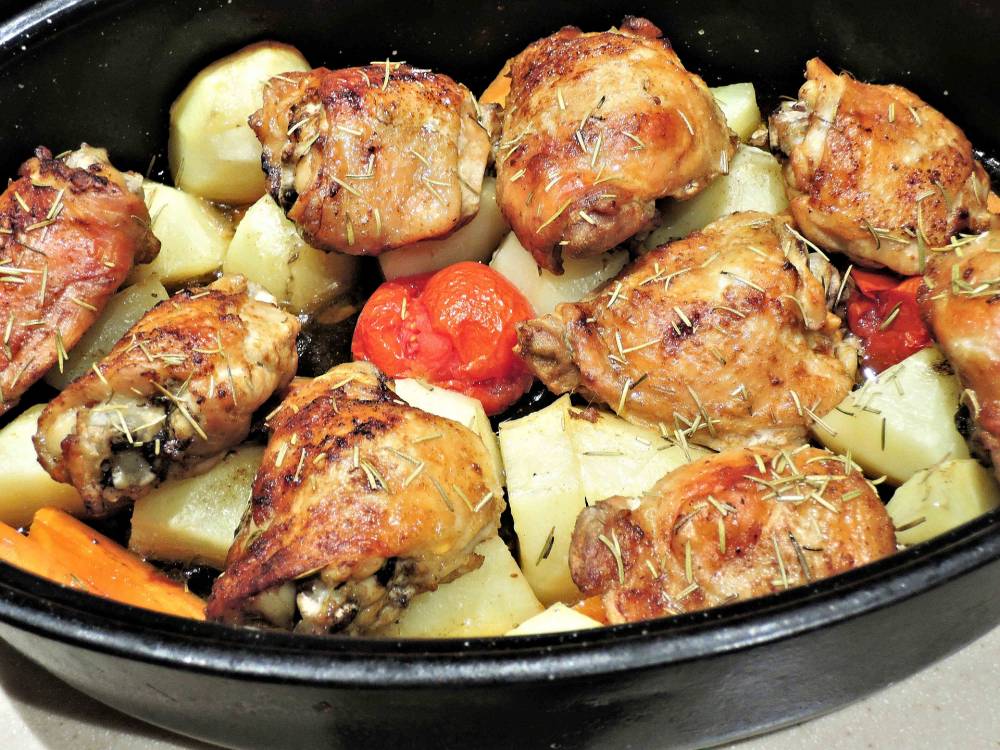Chicken thighs… they’ve dark, very tender meat. How much does a chicken thigh weigh anyway?

100 grams of skinless cooked chicken contains about 31-54 grams of protein, depending on the breed. It also carries 164 calories per 100 grams, with 70% of it coming from protein and 30% from fat.
On the other hand, a single chicken thigh boasts 13.5- 26 grams of protein per 100 grams, with 54% of its calories coming from protein and 46% from fat.
Some folks prefer having the thighs instead of the breasts and vice versa. In this article, we shall discuss chicken thigh weight.
Why Do I Prepare Chicken Thigh?
Chicken thighs are my favorite chicken pieces to throw on my air fryer or barbeque grill. Thanks to their fat content, they keep succulent and moist.
I can prepare my chicken thigh recipe in an oven or air fryer. Others do like to use an instant pot.
While chicken is the most consumed meat globally, its breasts and thighs are favorites of fitness enthusiasts, chefs, and home cooks.
Because they’re protein-rich, the two parts aid in building muscles, losing fat, adding weight, and maintaining masculinity.
Should I Use Chicken Breasts Or Chicken Thighs?
Skinless and boneless chicken thighs and breasts are great preferences for the main course. Chicken boasts versatility and can be cooked and used in various ways.
However, there are certain variances in chicken breast and thigh nutrition, so which one should you use?
Chicken Breasts
Boneless, skinless chicken breasts are very popular. They are high in protein, low in fat, delicious, and nutritious. If you are watching your weight, chicken breasts are the way to go due to their low-fat content.
You can have your breast either grilled, fried, skillet-cooked, or crock potted. Marinating with your favorite sauce is also a choice that adds more flavor to the chicken.
However, a lot of keenness is required when cooking this meat part as it tends to get overcooked and dry because they are low in fat, to the extent of sticking on the pan/grill surfaces.
So, adding a little oil to the pot is vital to keep them from sticking.
Chicken Thighs
Chicken thighs have fewer proteins and more fat compared to breasts. They make great cooking meat as they stick less on pots due to their fat.
The meat barely gets overcooked, and they stay moist and tender throughout. You can choose to cook:
- Chicken thigh in the oven
- Chicken thighs in the air fryer
- Chicken thighs instant pot
Even better, you can use your favorite marinade sauce to spice up your chicken thighs.
Chicken Breasts Vs. Chicken Thighs
Both chicken breast and thigh are ideal lean protein sources. Nonetheless, there is a slight difference in their nutritional value.
Chicken breasts boast 267 grams of protein per 3-ounce serving. In comparison, a single egg contains 7 grams of protein, and one ounce of beefsteak contains 7 grams of protein.
Contrarily, chicken breasts contain double the fat of breasts. One ounce of cooked chicken thigh contains 2 grams of fat, while 1 ounce of the breast contains 1 gram of fat.
When it comes to saturated fats, chicken thighs braze the train with only one additional gram compared to chicken breast.
One chicken thigh serving gives you 30% of niacin daily value, 155 of the DV for phosphorous, and 105 DV for riboflavin, zinc, and vitamin B-6.
Chicken breasts have fewer micronutrients, with 6% of Zinc DV, 6% riboflavin, 60% niacin DV, 25% vitamin B-6 DV and 20% phosphorous.
Your body needs zinc and phosphorous for DNA formation and Vitamin B-r, niacin, and riboflavin for an energy boost.
Does Cooking Matter?
Yes, it does. How you prepare your chicken thighs alters the amount of fat and calories. It is advisable to trim off visible fat and skin before cooking to reduce fat and calories in both parts.
You can also choose cooking methods that use zero to no added fat, such as baking, roasting, and grilling, compared to deep frying and shallow frying.

Although most people add fatty ingredients to chicken breasts to add more flavor, it is unnecessary since chicken has its natural taste.
Both chicken breasts and thighs are healthy bites. However, their benefits to your body lie behind your health goals. If you want to lose or watch your weight, stick to chicken breasts since they’re low in fat compared to thighs.
Nevertheless, if you’re looking at adding a little bit of weight, you can include skinless chicken thighs in your meals. The cooking should be done in a healthy way that doesn’t include too much additional fat.
Is It Bad to Eat Chicken Thighs?
Nope. Chicken thighs provide your body with a lot of proteins and unsaturated fats. The pieces are healthy options compared to red meat. Besides, your body needs some fat intake daily for an energy boost.
Notably, you should avoid cooking the thighs with skin on, and if you do, ensure that you remove it before eating if you are trying to reduce your fat and calorie intake. Why is this so?
Eating chicken thighs with the skin makes you fatter, which surpasses the fat percentage of chicken breasts.
Chicken thighs are rich in iron, making them ideal for people suffering from anemia. It also has a decent amount of zinc, which is virtuous for healthy skin, nails, and hair growth.
Precisely, chicken thigh fat doesn’t harm, but you can stop your practice if you dislike the thighs taste in your soup. Again, if you have issues with your cholesterol levels, you should stay away from chicken thighs.
Otherwise, chicken thighs are a nutritious and cheaper option compared to chicken breasts.
No matter how cooked, thighs are always delicious to the last bite, especially when cooked with the bone, which adds more flavor to the meat.
Are chicken thighs more tender than breasts?
Yes, they’re. Chicken thighs are preferred due to their tenderness and rich flavor, and chicken breasts are celebrated for their low-fat and lean meat.
Chicken thighs top the most liked dark poultry meat. You’ll appreciate their tenderness and taste.
Chicken thighs make strong cuts compared to other types of dark meat, which have more tendons. Why is this? They contain more fat than any other white meat part. What’s more, they become juicy, tender, and tasty when properly cooked.
With the increase in chicken consumption globally, you can find almost chicken thighs in every meat store and supermarket.
They’re sold skinless and boneless, skin-on and bone-in, and skinless and bone-in.
The three categories vary in price, and bone-in thighs tend to be more expensive than boneless ones. However, they still cost less compared to chicken breasts.
Frequently Asked Questions About Chicken Thighs
How much does a boneless chicken thigh weigh?
A boneless chicken’s thigh weight depends on the size of the chicken. Personally, when I purchase boneless and skinless thighs, they tend to weigh approximately 13.5 grams, 3 ounces, per thigh.
How much does one chicken thigh weigh in grams?
One chicken thigh weighs approximately 13.5 grams or 27 grams per 100 grams.
How much does a chicken thigh weigh in ounces?
A single boneless and skinless chicken thigh yields approximately 3 ounces of meat. So as a meat fan, you can have two thighs a day for good amounts of fat and protein.
How much does a chicken thigh weigh in oz.?
It weighs 0.5 oz and contains 58 calories per thigh. Now, you’ve got the answer to how much a chicken thigh weighs. Happy cooking!

